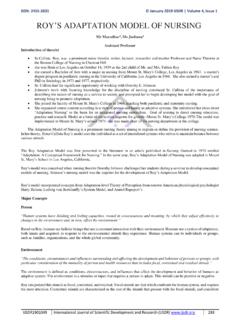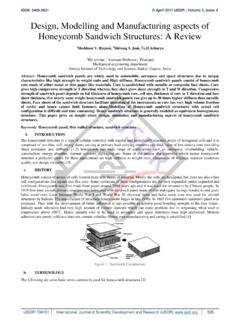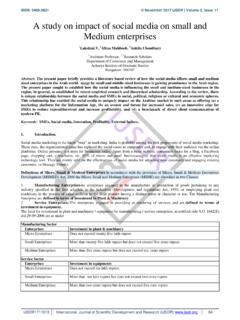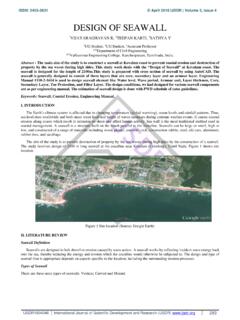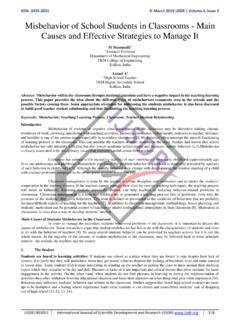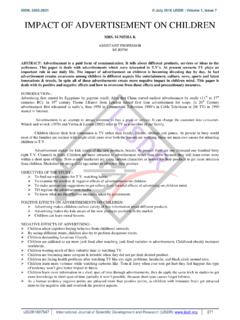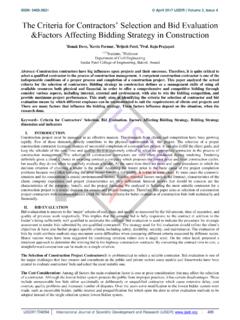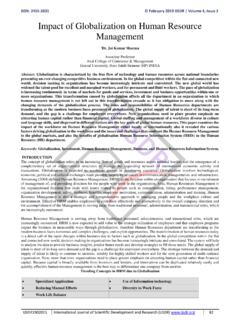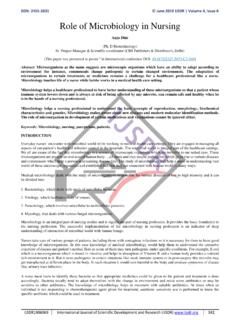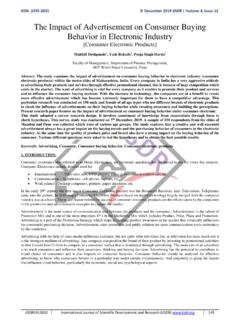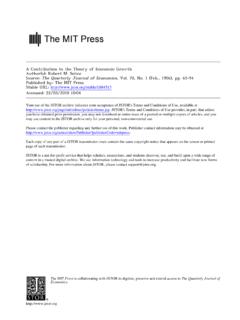Transcription of Profit Maximization Theory and Value Maximization Theory
1 ISSN: 2455-2631 June 2019 IJSDR | Volume 4, Issue 6 IJSDR1906054 International journal of Scientific Development and Research (IJSDR) 284 Profit Maximization Theory and Value Maximization Theory Dr. Abhishek Tripathi Dean Academics, SISTec MBA, Bhopal, India Abstract: The paper looks into the two theories of firm, the Profit Maximization and Value Maximization Theory . The paper focuses on the description of two concepts rather than comparison. It analyses the two theories from the application point of view. in managerial economics, the Theory of the firm based on Profit maximisation or Value maximisation is generally used in explaining managerial decision making. Managers who strive for maximisation of their own interests or utility rather than the firm s profits or Value are likely to be replaced by the shareholders of the firm. Alternatively, if managers do not fully exploit Profit opportunities, they will be taken over by other firm which sees its Profit potential.
2 Keywords: Profit Maximization , Value Maximization , Finance, Economic Model, Traditional and Modern Approach. Profit Maximization Theory In traditional economic model of the firm it is assumed that a firm s objective is to maximise short-run profits, that is, profits in the current period which is generally taken to be a year. In various forms of market structure such as perfect competition, monopoly, monopolistic competition the traditional microeconomic Theory explains the determination of price and output by assuming that firm s aim is to maximise current or short-run profits. This current short-run Profit maximisation model of the firm has provided decision makers with useful framework with regard to efficient management and allocation of resources. Profit is a difference between the total revenue and total cost. It may be noted that the concept of cost used in economic Theory and managerial economics is different from the concept of accounting cost used by accountants.
3 This difference in the concepts of costs makes the concept of profits used in economic Theory different from that used in its calculation by the accountant. It is to state here that economic profits is the difference between total revenue and economic costs. Thus, =TR-TC Where stands for total economic profits, TR for total revenue and TC for total economic costs. It is economic profits which firms try to maximise in their decision making about level of output to be produced and price to be charged for its product. This is illustrated in Where TR curve represents total revenue earned from selling varying amounts of output of a product. TC curve depicts total economic costs at different levels of output. It will be seen from the upper part of at OM level of output, total revenue equals total economic costs and therefore at this level of output the firm is just breaking even. Therefore, point B at which TR curve cuts TC curve is called break-even point.
4 Beyond this break-even level of output positive profits start accruing to the firm as it expands its level of output. Profits go on increasing till output level OQ is reached. It will be seen from the upper part of Figure that at output OQ, the difference between total revenue and total cost is maximum, that is, JH is the largest distance between the TR and TC curves. Therefore, JH is the maximum profits that can be earned by the firm, given the total revenue and total cost conditions. That the profits are maximum at output level OQ can be shown mathematically as under: = TR TC For the total profits to be maximum, the first derivative of the total Profit function should be zero. Thus, taking the first derivative of (1) above we have d =d (TR) /dQ-d (TC) dQ =0 or , d (TR)/ dQ= d(TC) dQ d (TR) /dQ and d(TC) dQ and are the slopes of TR and TC curves respectively. ISSN: 2455-2631 June 2019 IJSDR | Volume 4, Issue 6 IJSDR1906054 International journal of Scientific Development and Research (IJSDR) 285 It will be seen from that the slope of the TR and TC curves corresponding to output level OQ are the same as the slope of the tangents drawn to these curves are the same at this output level.
5 In the lower part of Figure we have drawn a total Profit curve TP which first rises and then beyond point N (corresponding to output level OQ) it starts falling indicating that profits are maximum at output level OQ. It can be seen from the upper part of Figure that profits start declining as output is expanded beyond OQ. Therefore, a firm which aims to maximise profits will produce output level of OQ, and will charge a price of its product which buyers are prepared to pay depending on the demand conditions. Since price or average revenue equals total revenue divided by a level of output, price charged by the firm at output level OQ is given TR/OQ or QJ/OQ The simple Profit -maximizing model of the firm provides very useful guidelines for the decision making by the firm with regard to efficient resource management. Thus, any business decision by a firm will increase its profits if the following conditions prevail: 1.
6 It brings about increase in total revenue more than increase in costs. 2. It causes increase in revenue, costs remaining unchanged. 3. It reduces cost more than it reduces revenue. 4. It reduces costs, revenue remaining the same. Limitations: Despite the merits of the Profit maximising model of the firm, it has two important limitations. First, it does not incorporate time dimension in the decision-making process by the firm. Secondly, it does not analyse the firm s behaviour under conditions of risk ISSN: 2455-2631 June 2019 IJSDR | Volume 4, Issue 6 IJSDR1906054 International journal of Scientific Development and Research (IJSDR) 286 and uncertainty. The modern model of the firm known as Firm s Value Maximization Model or Shareholder s wealth Maximising Model overcomes these limitations by incorporating time dimension into the managerial decision-making process. This model also considers risk involved in business decision-making.
7 Value Maximization Theory In modern managerial economics business decision making by managers are guided by the objective of maximising Value of the firm. Since in a corporate form of business it is the shareholders who are the owners of the firm, Value of a firm represents shareholders wealth. Thus, Value maximisation of a firm implies maximisation of shareholder s wealth. Therefore, this model is also known as shareholders wealth maximisation model . Thus modern managerial economics departs from the traditional economic Theory in which it is assumed that managers of corporate firms or owner-managers of self-owned business enterprises seek to maximise short-run profits. It has often been observed that firms sacrifice some short-run profits for the sake of higher profits in the future years. That is, they aim at maximising long-run profits. It is because of this objective that business enterprises incur huge expenditure on research and development, new capital equipment and expensive promotional schemes for their products.
8 Therefore, incorporation of time in the analysis of decision making by managers of business enterprises is essential. Modern Theory of the firm assumes that primary objective of the firm or their managers are to maximise Value of wealth or shareholder s wealth. Value of the firm is measured by calculating present Value of cost flows of profits of the firm over a number of years in the future. To do so profits of future years must be discounted because money Value a rupee of Profit in a future year is worth less than a rupee of Profit in the present. Therefore, the Value of the firm or shareholder s wealth is given by the present Value of all expected future profits of the firm. Thus, the Value of a firm may be expressed as follows: Value of the firm = Present Value of expected future profits Since profits are the difference between revenue (R) and cost (Q, the above equation (1) may be written as Value of the firm or PV = Where PV is the present Value of the future expected profits and therefore represents the Value of the firm, , 2 etc.)
9 Are the expected profits in each of the future years t1, t2, t3 and so forth up to any future year n which are considered by the firm for maximisation of expected future profits, i is the appropriate interest rate at which expected future profits are discounted to obtain the present Value of the firm. denotes the sum of the present values of expected future profits. It may be noted that in the above equations (1) and (2) time dimension has been included in the maximisation model by considering the expected future profits rather than only the profits of the current year. Secondly, this model also allows for the consideration of risk and uncertainty. For instance, if a series of future profits is highly uncertain (that is, it is likely to differ, substantially from the expected values of future profits) it will involve a great deal of risk. To compensate the shareholders for bearing this risk, the discount rate of interest can be raised.
10 Thus, the greater the risk involved in obtaining a future amount of Profit , the lower will be the Value placed by shareholders on future profits. We thus see that Value maximisation model of the firm enables us to overcome the two major shortcomings of the static short run Profit maximisation model. Further insights regarding maximisation of Value of the firm can be gained by decomposing TR and TC which determine profits made by the firm. TR is obtained from multiplying price with the quantity of output sold. Thus ISSN: 2455-2631 June 2019 IJSDR | Volume 4, Issue 6 IJSDR1906054 International journal of Scientific Development and Research (IJSDR) 287 TR = Pt. Qt Where Pt stands for the price of the product of the firm in a period and Qt is the quantity sold in that period. Cost can be obtained by taking a sum of variable cost and fixed costs. Thus TC= + F Where Vt is the average variable cost and Vt.
